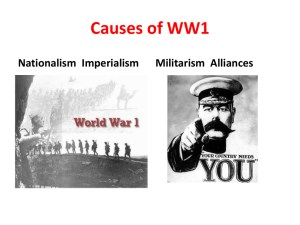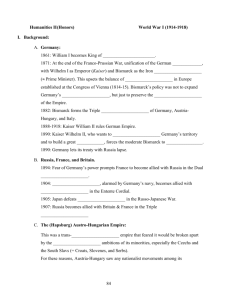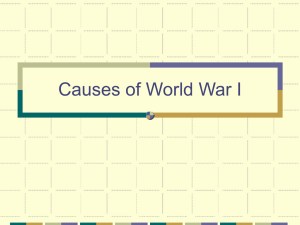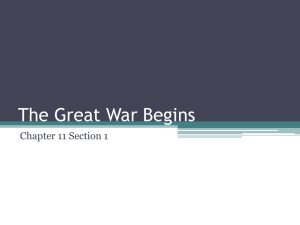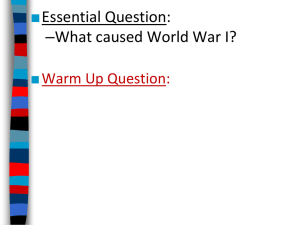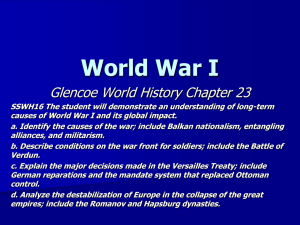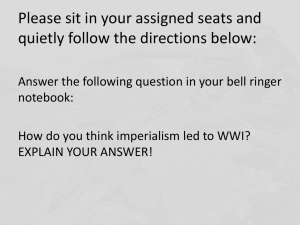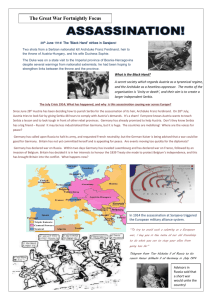Lesson One
advertisement
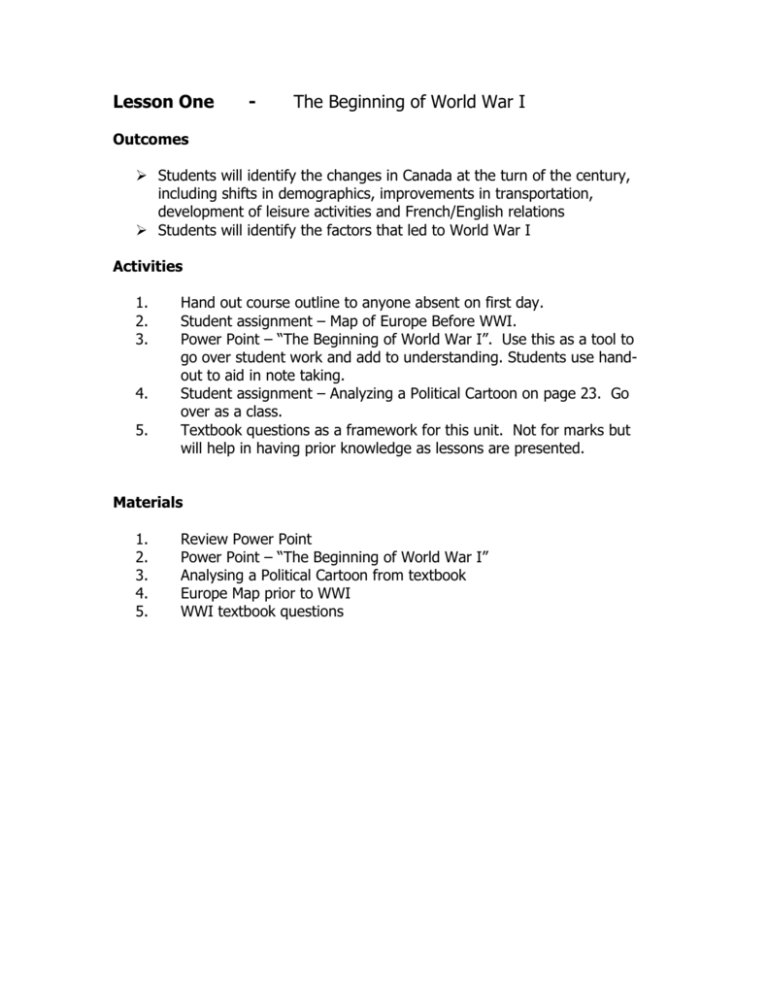
Lesson One - The Beginning of World War I Outcomes Students will identify the changes in Canada at the turn of the century, including shifts in demographics, improvements in transportation, development of leisure activities and French/English relations Students will identify the factors that led to World War I Activities 1. 2. 3. 4. 5. Hand out course outline to anyone absent on first day. Student assignment – Map of Europe Before WWI. Power Point – “The Beginning of World War I”. Use this as a tool to go over student work and add to understanding. Students use handout to aid in note taking. Student assignment – Analyzing a Political Cartoon on page 23. Go over as a class. Textbook questions as a framework for this unit. Not for marks but will help in having prior knowledge as lessons are presented. Materials 1. 2. 3. 4. 5. Review Power Point Power Point – “The Beginning of World War I” Analysing a Political Cartoon from textbook Europe Map prior to WWI WWI textbook questions Socials 11 Name ___________________________ Block ______ EUROPE BEFORE WWI Use your Counterpoints text page 28 to outline, label and shade in the empires and countries that existed prior to WWI. Label the Triple Alliance countries with an “A” Label the Triple Entente countries with an “E” Make note of the Alliance allies Make note of the Entente allies Socials 11 Name ___________________________ Block ____ THE CAUSES OF WWI Cause #1 Cause #2 Cause #3 Road to war… Socials 11 Name ___________________________ CANADA AND WORLD WAR I – Chapter 2 questions 1. What e “isms” contributed to tension and an escalation to the Great War? 2. What event was “the spark that ignited an already tense situation”, culminating in the start of World War I? 2. Fill in the flow chart below according to what your textbook says about the alliances that were formed during this time in history. Triple Alliance Triple Entente Allies Allies Neutral Countries 3. Why were many Canadians “eager” to support Great Britain and be involved in the Great War? 4. Describe Sam Hughes’ contributions as Minister of Militia. 5. List some of the powers that the War Measures Act gave the Canadian government. 6. What was the goal of Germany’s Schlieffen Plan? 7. Use figure 2-8 on page 30 to describe what life would have been like for a soldier in a trench. 8. What is a battle of attrition? 9. What does “Total War” mean for a country? 10. Briefly describe these 4 battles including the role that Canadian soldiers played. Ypres Somme Vimy Ridge Passchendaele 11. What was the role of the “Bluebirds”? 12. Describe the accomplishments of … Billy Bishop Roy Brown 13. What 2 events were factors that pulled America into the war? 14. Why did goods such as lumber, nickel and copper become so scarce in Canada? 15. What temporary measure did the government introduce to help pay for war? 16. Define the term “suffrage”. 17. How was propaganda used during the war? 18. What is conscription? What act did Prime Minister Borden pass to introduce conscription? 19. Why were recruits lower from Quebec than from other provinces? 20. Why did Borden pass the Military Voters Act and the Wartime Elections Act? 21. Describe the political change in Russia in 1917. 22. Outline the ways that Germany was allotted blame for WWI. Teacher notes Austria's Ferdinand Assassinated in Bosnia - Trigger to War (June 28, 1914): Ferdinand, the heir to the Austria-Hungarian throne was assassinated while visiting Sarajevo, Bosnia by a Bosnian Serb revolutionary. The culprit escaped into Serbia. Serbia and Bosnia were in the midst of a pro-Slav movement, which opposed Austrian possession of Slav lands in the Balkans, such as Bosnia. Austria elected to deal harshly with Serbia, offering a list of steep demands. Austria-Hungary's demands included strict Serbian compliance with an investigation, harsh punishment against the suspected revolutionary group (the Young Bosnians), all with close Austrian oversight. Serbia was on the verge of accepting in order to avoid war over the matter, but was reassured support by Russia, who jumped on the opportunity to assert its will and influence in the Slavic nations of the Balkans. Austria consequently delared war on Serbia. Russia followed with a declaration of war on Austria-Hungary, setting into motion a chain reaction which brought the other European powers into the conflict, bringing to a head the tensions that had been building up for decades, instigating WWI. Further Understanding: Causes of World War I 1. Colonial Rivalries. European powers shared an insatiable appetite for expansionism and wealth creation. Natural resources were required to feed their growing industrialization capabilities. Most land throughout the world the could be feasibly conquered was already under European colonial control, leaving colonial powers to fight over increasingly limited territory, such as the African interior. By the late 1800s, bitter rivalries developed as colonial powers butted heads with greater frequency. 2. Arms Race. As economic rivalries and colonial competition came to a boiling point, nations began to build their military arsenals at an unprecedented rate. Armament build-ups continued to spiral out of control as European powers sought to gain a military advantage over one another. 3. Unmitigated Nationalism. European kingdoms had given way to nation-states throughout the 1800s following the Napoleonic Wars, lending widespread support to colonial, economic and military expansion. The Napoleonic Wars taught Europeans that it was critical to consolidate and strengthen one's nation in relation to potential rivals. Furthermore, new nations and new colonial powers such as the German Empire and Italy (formed comparatively recently, during the mid-1800s) were especially fervent, as they had been under foreign domination for so long, and were eager to reverse the situation. Their tactics became increasingly brutal and hostile as they felt compelled to play catch up with established colonial powers such as the United Kingdom, France and Spain. 4. Complex Network of Alliances. As tensions grew, alliances were formed. Nearly all of the European powers were mobilized and prepared to go to war at the drop of a hat. As Germany grew in strength, France and the UK formed an alliance to keep it in check. By the late 1800s, Germany was threatening UK naval dominance. France had just lost an important region to Germany from their loss in the Franco-Prussian War of 1870, and remained vulnerable to this still-growing power along their eastern border. Russia and Austria-Hungary had become distrustful of one another, as both were interested in gaining control over the Balkans. France and the UK recruited Russia to their alliance to force Germany into a two-front war in the event of hostilities, while Russia sought help in order to counterbalance the Austrian threat. Consequently, Germany and Austria-Hungary became natural bedfellows. They recruited the Ottoman Empire based in Turkey to neutralize Russia, with the promise of regaining lost Balkan territories used as a carrot. 5. The Catalyst. The Balkans had become a tinder box, as both Austria and Russia had designs on the region. When the heir to the Austrian throne was assassinated in Bosnia in 1914, Austria reacted harshly, resulting in war. Serbia was prepared to concede to Austria, but Russia made a strong showing of support, giving it courage to standup to Austria. Austria then declared war, and all the treaties and alliances were triggered, initiating The Great War (WWI). Austria Invades Serbia to Begin War (July 28, 1914): Austria-Hungary launches invasion of Serbia to start the Great War (WWI). In July, Austrian heir to the throne was assassinated in Bosnia (part of Austria-Hungary Empire), as part of a pan-Slavic movement based out of Serbia, with the objective of limiting Austrian influence and control in the Balkans. Russia encouraged Serbia to resist AustriaHungary's subsequent demands, which included investigating and prosecuting the suspected group, under the oversight of the Austrians. Consequently, Austria invaded in August. Russia subsequently invaded Austria-Hungary, limiting its ability to conquer Serbia. In which case, Serbia was able to repel the Austrian offensive until late 1915. Primary Combatants as of 1914: Allied Powers: United Kingdom France Russia Canada Serbia Montenegro Central Powers: German Empire Austria-Hungary Ottoman Empire Germany Invades Belgium/France - Beginning Trench Warfare (August 4, 1914): Germany invades Belgium as part of its plan to quickly defeat France, enabling it to divert most of its military resources to the eastern front to fight Russia. In order to out-flank the French military, which would concentrate along shared border and around Paris, it needed to launch from inside Belgium. Therefore, Belgium's neutrality was not honored. Germany enjoyed early success, steamrolling Belgium, and quickly taking ground inside France. However, France - with the help of UK and Canadian troops - was able to bog down the German military in trench warfare, forcing them into a two-front war after all. Declarations of War: 1. Austria-Hungary Declared War on Serbia: When Serbia declined to accept harsh demands by Austria after Ferdinand assassination, Austria-Hungary declared war. Serbia was encouraged to refuse terms by Russia, who offered support, eyeing an opportunity to gain influence and control in Slavic Balkans. Slav-dominated Russia believed itself to be the natural leader of the Slavic world. 2. Russia Mobilized Along Austria-Hungarian Border: As part of its agreement to protect Serbia, Russia prepared to invade Austria-Hungary, amassing troops along their shared border. 3. Germany Declared War on Russia and France: The German Empire, an ally of Austria-Hungary, realized that it would be drawn into a two-front war with France and Russia. Its only chance at victory was to quickly strike and defeat France, allowing it to concentrate its troops along its eastern borders with Russia before it could mobilize its massive army. It had been calculated that Russia would be the slowest of the three to mobilize, while France could be forced to surrender fairly quickly. Therefore, Germany could not afford to wait until Russia invaded. By then, it would be too late, as France and Russia would be be fully mobilized on either side. 4. UK and France Declared War on Germany and Austria-Hungary: As part of its plan, the German Empire began its invasion to the west within less than two weeks of declaring war on France. Its military strategy to defeat France included the conquest of Belgium, a neutral nation. This action, along with the fact that it was an ally with France, drew the UK into WWI. 5. Ottoman Empire Joined Central Powers: The German Empire and AustriaHungary recruited the Ottoman Empire as war declarations were being made, enjoining them to their side. The Ottomans were important, since they would force Russia into a two-front war, diverting some of their military resources to the south. Plus, they could attack British assets in the Middle East, while also enabling the Central Powers to enclose the Balkans on either side. The Ottoman Empire was promised the return of territory they had lost in the Balkans, as well as territories lost to the UK in the Middle East. Naval Battle of Coronel - South America - Germany vs UK (Nov. 1, 1914): Germans invade and defeat British naval vessels off the southern coast of Chile, toward the southern tip of South America. This prompts the UK to send reinforcements, which meet the German squadron off the coast of the nearby Falkland Islands, a month later (Dec. 8). The British utterly destroy the Germans, ending their presence in the region. Russia Invades German Empire and Austria-Hungary (1914): Russia mobilized troops along both its German and Austria-Hungary borders to support Serbia. Russia had encouraged Serbia to defy Austrian demands, pledging its aid in an attempt to increase its power and influence in the Slavic Balkan territories. This prompted Germany and Austria to declare war against Russia, eliciting the Russian invasions. Germans successfully defend against Russian invasion of East Prussia (1914). Russia Conquers Galacia Portion of Austria-Hungary (1914): Russians successfully invade Austria-Hungary, controlling most of Galacia. Forces Germans to divert more troops to aid its ally. African Theater (1914): West Africa: UK and France immediately gain the upper hand in German colonies of Togo and Kamerun. South Africa: Germans invade South Africa, counting on support of Boers (Dutch farmers inherited by the British when they conquered South African from the Dutch), who had just revolted against UK rule a decade earlier. UK spends the remainder of 1914 consolidating control and securing loyalty among the Boers. East Africa: The Germans successfully defend their colonies of Tanzania, Burundi and Rwanda. Ottoman Empire Invades Russia (1914): The Ottomans joined the Central Powers just as the war started, with an invasion of Russia, with the purpose of forcing it into a two-front war. The Ottomans' motivation was to regain territories lost in the past century, including Balkan territories, Middle Eastern territories to the UK, and Caucasus territories to Russia. Russia gained a decisive upper hand by the end of 1914. UK-German Naval Warfare (1914): The UK devastates the German fleet off the west coast of South America, ending the German threat in that part of the world. The UK also successfully blockades the north coast of the German Empire, constricting their ability to bring in needed supplies. However, Germany is successful in harrassing Allied vessels in the North Atlantic. United Kingdom imposes a naval blockade of Germany (1914). Canada Joins United Kingdom (1914): Canada quickly joined the Allies to support the UK, its most important ally in the world, and to foster a greater sense of nation, as it was still a self-governing federation under British dominion. Canadia soldiers primarily served in the trenches in France, fighting against the Germans.
